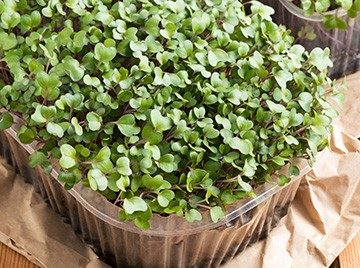FOR IMMEDIATE RELEASE
ACS News Service Weekly PressPac: February 16, 2022
Broccoli and kale microgreens pack a nutritional punch that varies with growing conditions
“Profiling of Polyphenols and Glucosinolates in Kale and Broccoli Microgreens Grown under Chamber and Windowsill Conditions by Ultrahigh-Performance Liquid Chromatography High-Resolution Mass Spectrometry”
ACS Food Science & Technology
Although microgreens were initially gourmet ingredients for upscale restaurants, they’ve become popular among gardeners and home cooks. Despite their “superfood” label, the levels of healthful compounds, such as phytonutrients, in most varieties of microgreens are unknown. Researchers in ACS Food Science & Technology now report that kale and broccoli microgreens grown in either windowsills or under commercial growing conditions are rich in phytonutrients, though the levels of some compounds varied considerably between the two environments.
As indoor gardening has taken off in recent years, microgreens have added a pop of color to the windowsills of many homes. The most commonly planted varieties of these small seedlings are from the Brassica family, which includes broccoli, kale, cabbage and mustard. The mature, fully-grown versions of these vegetables are rich in vitamins, minerals and phytochemicals, and environmental conditions can impact the plants’ nutritional contents. But not much is known about the levels of these compounds in young microgreens. In a previous study, Thomas Wang, Pei Chen and colleagues observed that red cabbage microgreens had higher amounts of phytonutrients that have been reported to have antioxidant and anticancer properties, including polyphenols and glucosinolates, than the full-grown vegetables. However, similar assessments haven’t been done on other Brassica seedlings. So, the researchers wanted to measure the levels of polyphenols and glucosinolates in broccoli and kale microgreens, and then compare data from those grown on windowsills to those raised in commercial growth chambers.
The researchers placed trays of newly planted broccoli and kale seeds either on a windowsill in natural sunlight or inside a temperature- and humidity-controlled refrigerator-like growth chamber with artificial sunlight for 12 hours a day. Ten full days after seeding, the team harvested the plants and assessed the phytonutrient content with a liquid chromatography high-resolution mass spectrometry system. The broccoli and kale microgreens were rich in polyphenols and glucosinolates, no matter how they were grown. But there was considerable variability in the amounts of individual compounds when comparing the two growth environments. For instance, three flavanol compounds that contribute to the plant’s dark color and bitter taste were higher in windowsill-grown microgreens. However, chamber-grown plants had higher levels of two glucosinolates, which are antioxidant- and anticancer-related compounds. Overall, the growth environment for kale and broccoli microgreens affects the abundance of individual phytonutrients, the researchers say, which could affect their flavor and potential health benefits.
The authors acknowledge funding from U.S. appropriated funds to the U.S. Department of Agriculture, Fundamental Research Funds for the Central Universities of China and the State Scholarship Fund of China Scholarship Council.
###
The American Chemical Society (ACS) is a nonprofit organization chartered by the U.S. Congress. ACS’ mission is to advance the broader chemistry enterprise and its practitioners for the benefit of Earth and all its people. The Society is a global leader in promoting excellence in science education and providing access to chemistry-related information and research through its multiple research solutions, peer-reviewed journals, scientific conferences, eBooks and weekly news periodical Chemical & Engineering News. ACS journals are among the most cited, most trusted and most read within the scientific literature; however, ACS itself does not conduct chemical research. As a leader in scientific information solutions, its CAS division partners with global innovators to accelerate breakthroughs by curating, connecting and analyzing the world’s scientific knowledge. ACS’ main offices are in Washington, D.C., and Columbus, Ohio.
To automatically receive press releases from the American Chemical Society, contact newsroom@acs.org.
Note: ACS does not conduct research, but publishes and publicizes peer-reviewed scientific studies.
Media Contact
ACS Newsroom
newsroom@acs.org


